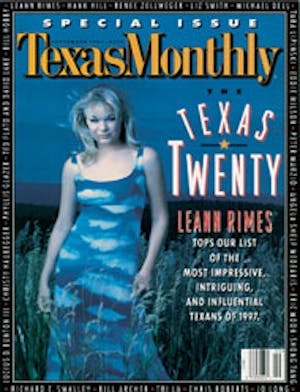PETER MARZIO, THE HANDSOME, well-spoken 54-year-old director of Houston’s Museum of Fine Arts, has a reputationbut it has nothing to do with his private life. First, he is generally conceded to be the most stunningly successful fundraiser the museum has ever had. Second, he is looked upon as an intuitive social animal, a man who was born knowing how to work a ballroom as easily as a boardroom. Third, he is considered a bit of a clotheshorse.
Each element forms part of Marzio’s distinctive and effective public persona, but the truth of the matter is a little different. Yes, Marzio dresses well because it’s expected of someone in his position, but he is actually rather oblivious to clothes. (On a recent morning he was observed wearing a new suit with one jacket pocket still stitched shut.) By the same token, although he and his wife, Frances (who is the assistant to the chairman of the museum’s board and recently curated the record-breaking “Splendors of Ancient Egypt” exhibit), are regulars on the glitzy dinner-party and cultural-event circuit, Marzio confesses with just a shade of wistfulness, “I’m really a hermit.” The one part of the picture that is indisputably true is that during the fifteen years he has headed the Museum of Fine Arts, the institution has become one of the ten best-funded art museums in the country. In other words, Peter Marzio can show you the money.
When he took over in 1982, the museum’s endowment was approximately $26 million; today it is more than $300 million. Its annual attendance was 342,000; now it is 725,000. Its membership was 8,000; today it totals 38,000. (In contrast, the Dallas Museum of Art’s endowment is about $60 million, attendance 450,000, membership 20,000.) Predictably, Marzio tries to sidle out of the spotlight, deflecting credit onto his staff and the board of directors (“The trustees do the groundwork,” he insists. “Without them, I couldn’t raise a dime”). But the man at the helm is obviously doing something right. On a cloudy morning last spring, dozens of visitors were lined up outside the sweeping glass facade of the museum’s Mies van der Rohe addition, waiting for the doors to open so they could purchase tickets to the blockbuster exhibit “Jewels of the Romanovs.”
Nothing in Marzio’s youth foreshadowed his present career. Broad-shouldered and solidly built, he was raised by his Italian uncles in New York and went to college on an athletic scholarship. Then his life took a 180-degree turn. On a visit to Manhattan’s Frick Collection, he found himself standing in front of Goya’s painting The Forge, and without any formal training, he instinctively understood how it workedits mass, line, and tone. The moment was decisive, and Marzio ultimately obtained a doctorate in history and art history from the University of Chicago. Several museum positions led to the directorship of the prestigious Corcoran Gallery of Art in Washington, D.C., and in 1982 the Museum of Fine Arts lured him to Houston.
Marzio has made an all-inclusive democracy the cornerstone of his vision for the museum. He wants it to be a place where anyone can feel comfortable in the presence of art. “When someone tells me that art is not as important as a welfare program,” he says, “I look at myself and say, That’s not true. Don’t denigrate art as a social force.’” Before he came to the museum, it was mostly frequented by the cognoscenti, and their complexions were mostly white. Today it has a vital and diverse constituency: Young and old flock to its social mixers, all third graders in the Houston Independent School District get free tours every year, an annual museum-sponsored 5K run ends with four thousand runners lounging around the shady Cullen Sculpture Garden, and photographs by talented inner-city youths are regularly displayed at the museum. Its exhibit strategy, which often pairs a crowd pleaser like “Jewels of the Romanovs” with one or two more-scholarly exhibits, exemplifies the new marketing savvy of museums around the country. To Marzio, it is how art museums will be able to survive beyond the millennium, something that is of more than professional interest to him. “I look at the museum as this little miracle,” he says, “a private art institution that is the people’s treasure.”
Two years from now, he hopes, the museum will be even more of a treasure. That is when the new Audrey Jones Beck Buildinga sleek, contemporary 185,000-square-foot space designed by Spanish architect Rafael Moneois scheduled to open, more than doubling the museum’s size and making it the sixth-largest art museum in the country. At other institutions, there might be some concern about funding such an undertaking, but Marzio and the trustees have already raised $105 million of the $115 million the project is expected to cost.
Somehow that does not come as a surprise.








